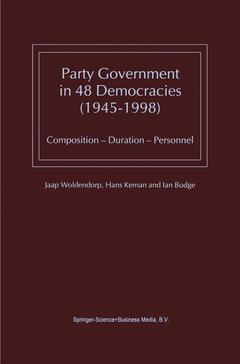Description
Party Government in 48 Democracies (1945–1998), 2000
Composition — Duration — Personnel
Authors: Woldendorp J.J., Keman Hans, Budge I.
Language: English
Subjects for Party Government in 48 Democracies (1945–1998):
210.99 €
In Print (Delivery period: 15 days).
Add to cart
Party Government in 48 Democracies (1945-1998)
Publication date: 12-2010
580 p. · 15.5x23.5 cm · Paperback
Publication date: 12-2010
580 p. · 15.5x23.5 cm · Paperback
210.99 €
Subject to availability at the publisher.
Add to cart
Party Government in 48 Democracies (1945-1998)
Publication date: 12-2000
580 p. · 15.6x23.4 cm · Hardback
Publication date: 12-2000
580 p. · 15.6x23.4 cm · Hardback
Description
/li>Contents
/li>
Since the 1980s, political scientists have developed a renewed interest in the study of political institutions, based on the assumption that "institutions matter" -that is, that formal governmental institutions and constitutional-legal rules (as well as informal institutions like parties and interest groups) are crucial determinants of the shape of politics and policy outcomes. In this respect, the "new institutionalism" resembles the "old institutionalism" of pre-behaviorist days, but the crucial difference between the two is that the new institutionalists are committed to systematic empirical testing of their hypotheses, at least in principle. In practice, however, especially in compara tive analyses, this goal has often been frustrated by the lack of reliable data for a large number of countries. Researchers have therefore usually been limited to testing their hypotheses with modest data sets collected for their own particular purposes. Of all of the political institutions, the executive branch of the government is by far the most important; it can be regarded as the irreducible core of government and the principal embodiment of political authority with specific powers that are not lodged elsewhere in the political system. Almost all countries in the world, and certainly all modem democracies, have an executive body called "government", "cabinet", or "administration" (as in the term "the Clinton administration") that has the main responsibility for running the country's public affairs.
1. Party Government and Parliamentary Democracy.- 2. The Institutional Features of Parliamentary Government.- 3. The Stability of Parliamentary Democracies: Duration and Termination of Governments.- 4. Australia.- 5. Austria.- 6. Bangladesh.- 7. Belgium.- 8. Botswana.- 9. Bulgaria.- 10. Canada.- 11. Czech and Slovak Federative Republic.- 12. Czech Republic.- 13. Denmark.- 14. Estonia.- 15. Finland.- 16.1 France IV.- 16.2 France V.- 17. Germany.- 18. Greece.- 19. Guyana.- 20. Hungary.- 21. Iceland.- 22. India.- 23. Ireland.- 24. Israel.- 25. Italy.- 26. Jamaica.- 27. Japan.- 28. Latvia.- 29. Lithuania.- 30. Luxembourg.- 31. Macedonia.- 32. Malta.- 33. Namibia.- 34. The Netherlands.- 35. New Zealand.- 36. Norway.- 37. Pakistan.- 38. Poland.- 39. Portugal.- 40. Romania.- 41. Slovakia.- 42. Slovenia.- 43.1 South Africa I.- 43.2 South Africa II.- 43.3 South Africa III.- 44. Spain.- 45. Sri Lanka.- 46. Sweden.- 47. Switzerland.- 48. Turkey.- 49. United Kingdom.- 50. Russian Federation.- 51. United States of America.- Sources: Literature and Internet Sites.- Authors.
© 2024 LAVOISIER S.A.S.




